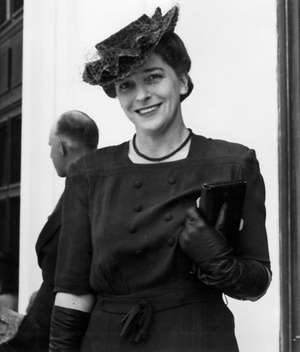 Right: In 1949, Federal MP Enid Lyons became the first Australian female cabinet member.
Right: In 1949, Federal MP Enid Lyons became the first Australian female cabinet member.
 Found a word you're not familiar with? Double-click that word to bring up a dictionary reference to it. The dictionary page includes an audio sound file with which to actually hear the word said. Found a word you're not familiar with? Double-click that word to bring up a dictionary reference to it. The dictionary page includes an audio sound file with which to actually hear the word said. |
 Background information
Background information
Background
(The information reprinted below is an abbreviation of that contained in the Wikipedia entry titled 'Women and government in Australia'. The full text of the entry can be accessed at http://en.wikipedia.org/wiki/Women_and_government_in_Australia)
Women and government in Australia
From the turn of the 20th century, women have participated in government in Australia.
Following federation, the government of the newly formed Commonwealth of Australia passed the Commonwealth Franchise Act 1902 allowing most women to both vote and stand in the federal election of 1903. South Australia and Western Australia granted women the vote before federation, and the states of New South Wales, Tasmania, Queensland and Victoria also passed legislation allowing women to participate in government at the state and local levels following federation. Indigenous Australian women did not achieve suffrage at all levels of government and in all states and territories until 1962.
Australia was the first country to allow women to stand in elections; however, the country has been slow to have women become members of its parliaments. In most countries, women entered parliament soon after gaining the right to stand. In Australia, no woman was successful at a federal election until 1943.
The major Australian political parties did not support any female candidates until the Second World War; until this time every female candidate had been independent or backed by one of the minor political parties. In 1943 and with major party backing, Dame Enid Lyons was elected to the House of Representatives as the member for the Division of Darwin, which was located in Tasmania, and Dorothy Tangney was elected to the Senate representing Western Australia. In 1949 Enid Lyons became the first female cabinet member; however her appointment as Vice-President of the Executive Council did not involve the administration of any department. In 1966 Senator Dame Annabelle Rankin became the first woman with a federal portfolio when she became Minister for Housing. In 1975 Senator Margaret Guilfoyle was the first female cabinet minister with a portfolio, Education.
In general, women have been slow to enter all levels of politics in Australia. The first female Premier was Carmen Lawrence, leading Western Australia for three years until 1993. Currently, a female Premier leads the state of Tasmania (Lara Giddings), and Chief Minister Katy Gallagher leads the Australian Capital Territory.
In 1983 Ros Kelly was the first woman to give birth while an MP. In 1986 there were two firsts, Joan Child became the first female Speaker of the House of Representatives and Janine Haines became the first woman to lead a parliamentary party when she became head of the Australian Democrats. Margaret Reid became the first female President of the Senate in 1996.
On June 24, 2010, Julia Gillard became the first woman to lead one of the major political parties at the federal level as Leader of the Australian Labor Party, as well as the first female Prime Minister of Australia. However, as it became clear that her minority government was headed for an unprecedented landslide defeat, she was deposed by her own party on June 26, 2013, in favour of former Prime Minister Kevin Rudd, whom she had replaced in a similar coup.
